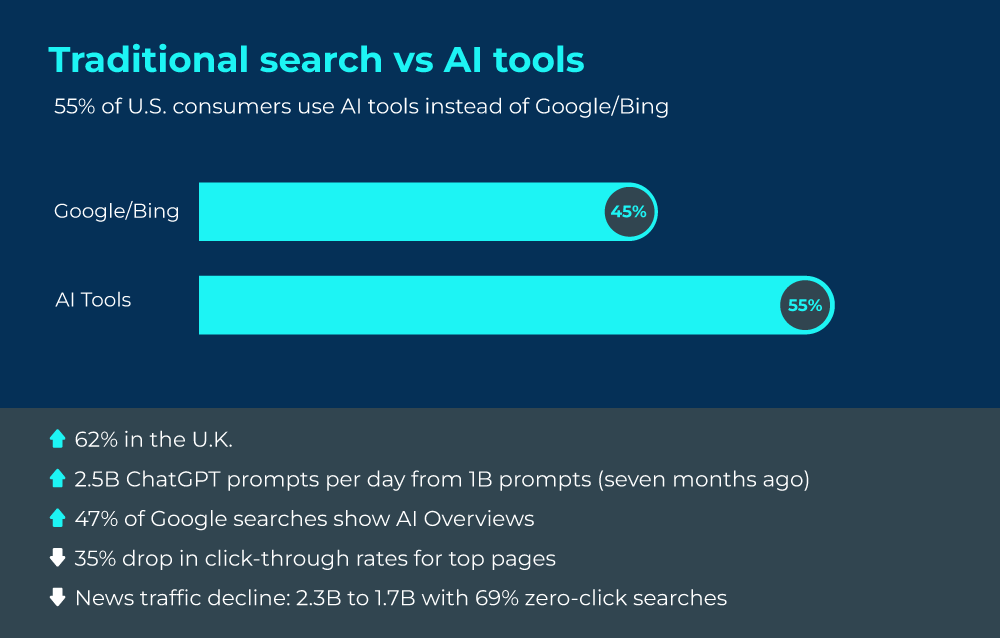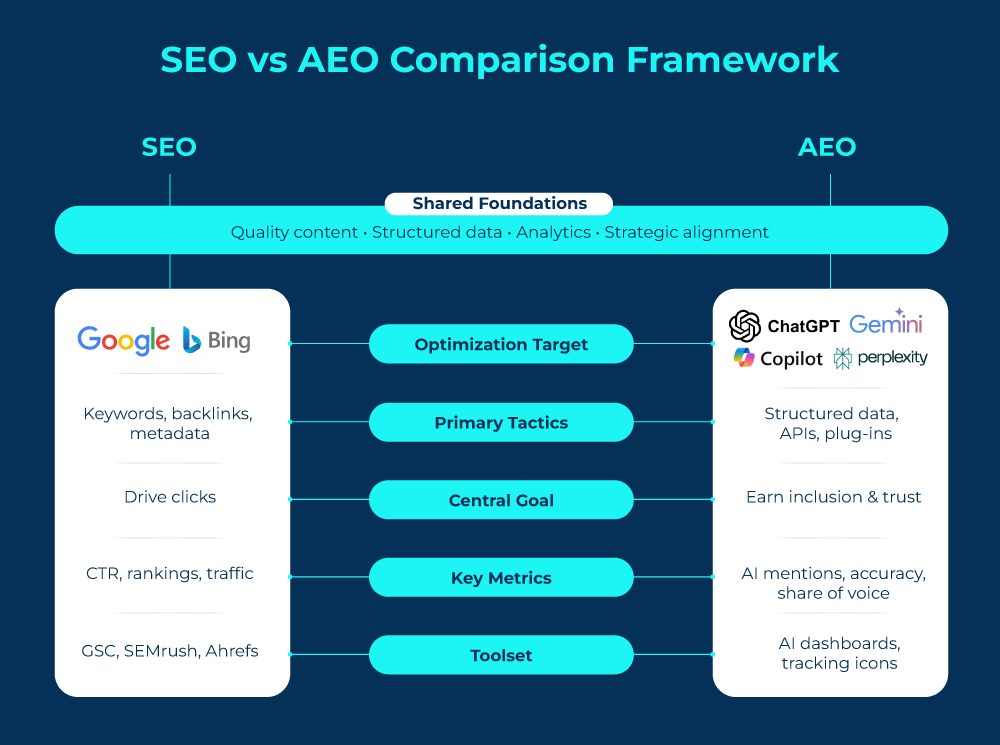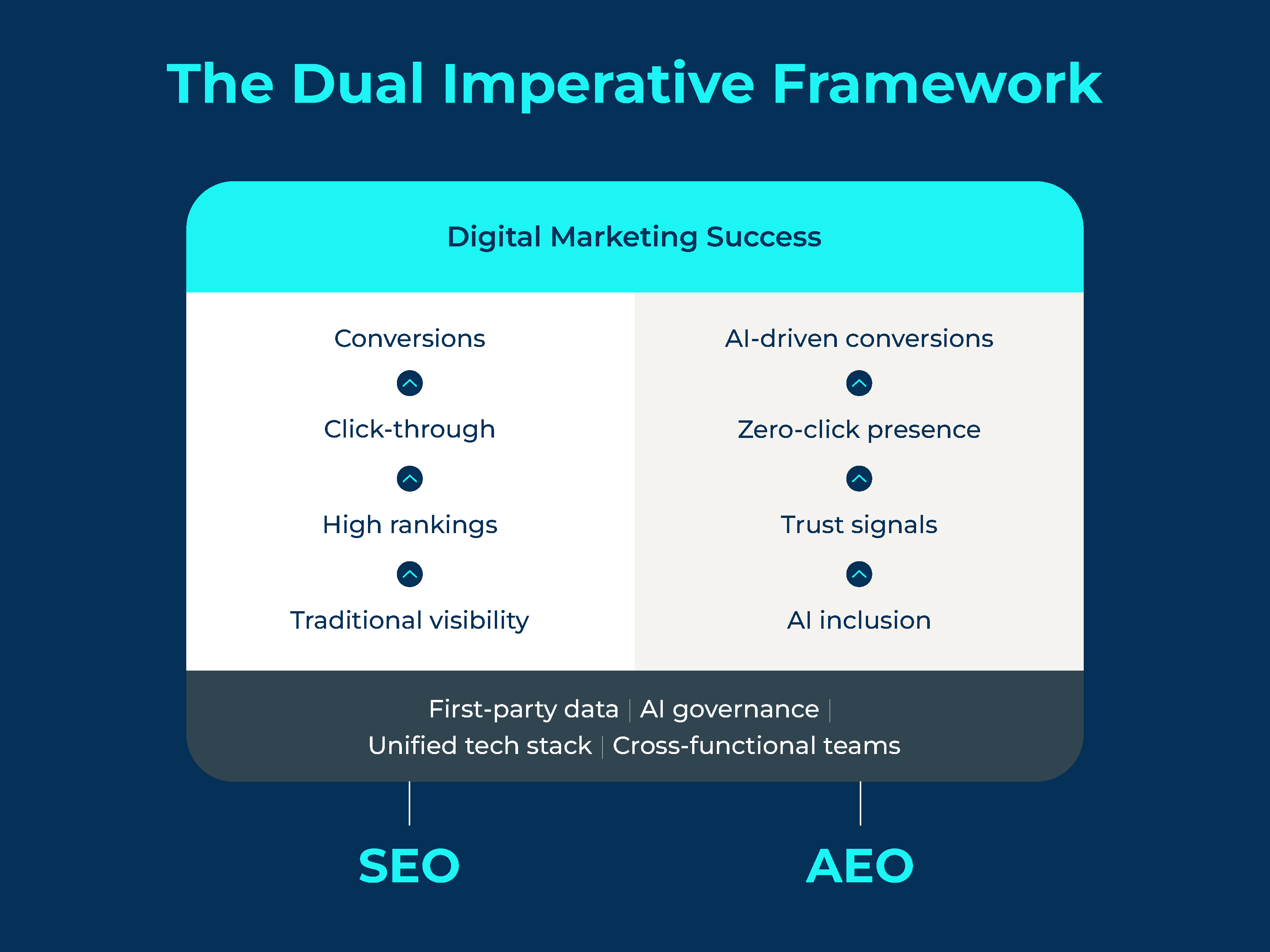%20(1).jpg)
The digital marketing landscape is undergoing a profound transformation. According to Tom's Guide, 55% of U.S. consumers now use generative AI tools like ChatGPT and Gemini instead of traditional search engines for certain tasks, a figure that climbs to 62% in the U.K. ChatGPT alone now processes over 2.5 billion prompts daily, a dramatic increase from 1 billion just seven months prior.
Meanwhile, Google's AI Overviews are reshaping user behavior at scale. Now appearing in 47% of Google searches, these AI-generated summaries have contributed to up to a 35% drop in click-through rates for top-ranking pages. The impact extends to news publishers as well: organic traffic to major news sites plummeted from over 2.3 billion in mid-2024 to under 1.7 billion by May 2025, while "zero-click" news searches surged from 56% to 69%.

These shifts mark a clear inflection point. Businesses must now master two disciplines simultaneously, maintaining SEO as the bedrock of digital visibility while embracing AEO (Answer Engine Optimization) to become discoverable in AI-first environments.
Search Engine Optimization remains the cornerstone of digital marketing, ensuring your brand appears prominently in traditional search results. Core SEO practices include:
Content strategy through long-tail keywords and semantic optimization that matches user intent. Technical SEO foundations like site speed, mobile responsiveness, and schema markup that enable search engines to crawl and understand your content. Authority building via backlinks, thought leadership, and domain credibility that signal trustworthiness. On-page optimization including metadata, readability, and internal linking that enhance both user experience and search visibility.
SEO's value proposition remains compelling. According to Semrush, the top organic result typically captures 22–27% of clicks, and Backlinko research shows that moving up a single search rank can increase CTR by nearly 3%.
However, with AI Overviews consuming more screen real estate and user attention, even high-ranking pages face diminished traffic, a reality that demands strategic adaptation. Historically brands could always buy their way to the top with Paid Search, but with answers moving off-platform that strategy will no longer carry the same impact.
AI Engine Optimization represents the emerging discipline focused on visibility within AI-generated answers, from voice assistants and chatbots to AI-powered search summaries and conversational platforms.
Effective AEO strategies encompass:
Data structuring through schema markup, JSON-LD, APIs, and knowledge graphs that make your content machine-readable. Source credibility via authoritative, well-cited content that AI systems recognize as trustworthy. First-party data feeds that expose product information, pricing, and specifications in formats AI can parse. Brand visibility signals through clear FAQ-style content and strong brand mentions that increase citation likelihood. AI partnerships including integrations with Copilot plug-ins, Vertex AI connectors, and other AI ecosystem platforms.
In an era where users increasingly find answers within AI summaries without clicking through to websites, the "zero-click" phenomenon, being visible and trusted in those AI outputs has become mission-critical. As capabilities evolve over time and we see further integration of shopping experiences embedded within these Answer environment, this will truly become a transformative channel much like Search was in the early days of Digital enablement.
While SEO and AEO share important commonalities, they diverge in execution and measurement.

What They Share:
Where They Differ:
Optimization Target: SEO focuses on traditional search engines like Google and Bing, while AEO targets AI systems including ChatGPT, Gemini, Copilot, and Perplexity.
Primary Tactics: SEO relies on keywords, backlinks, metadata, and site speed. AEO emphasizes structured data, APIs, AI plug-ins, and authoritative content formats.
Central Goal: SEO aims to drive clicks through high search rankings. AEO seeks inclusion and trust within AI-generated answers.
Key Metrics: SEO tracks rankings, traffic, CTR, and conversions. AEO measures AI mentions, answer accuracy, share of AI voice, and AI-driven conversions.
Toolset: SEO leverages established platforms like Google Search Console, SEMrush, and Ahrefs. AEO requires custom monitoring dashboards, AI referral tracking, and adapted analytics integrations.
Targeting: While SEO never had any true ability to target and segment, the ability to manipulate “personas” can function in a similar manner to paid targeting. Thinking about the different ways prompts are written and answered can allow for a saavy team to create more differentiation in responses to different customer groups.
Don’t overcorrect, evolve
SEO principles and guidelines are going to continue to be a foundational approach to addressing AEO. Don’t stop and just fully turn attention to LLMs, but identify those additional elements required and build capabilities around them. Good content is still King, but being able to now consider personas and how that content shows up to an LLM is crucial.

Strengthen First-Party Data Infrastructure
Build shared taxonomies, ensure data consistency across platforms, and create durable first-party feeds. This infrastructure underpins both traditional search visibility and AI discoverability. Find out what your customers are engaging with and find ways to address it based on personas, specific phrasing and positioning of your brand to LLMs.
Build Strategic Fluency Across Teams
Empower analytics teams to solve business problems, not merely report data. Foster cross-functional collaboration among marketing, analytics, product, and finance. Adapt roles to oversee generative content quality and accuracy.
Create a Unified MarTech-AdTech Stack
Break down organizational silos. Integrate CDPs, DSPs, analytics platforms, and attribution systems to deliver unified insights across both traditional and AI-driven discovery pathways. As LLMs build out their capabilities with more formal integrations having the right toolset will enable flexibility for integration when the time comes.
.png)
SEO has been the bedrock of being found. AEO is the future of being trusted and included in AI-mediated customer journeys.
Together, they form a dual imperative: SEO ensures visibility in traditional search; AEO ensures relevance and inclusion in AI-driven discovery. The future belongs to organizations that govern AI responsibly, build lasting data foundations, and integrate both disciplines with strategic rigor.
At Blend360, we help clients navigate this transformation, not just to adapt, but to thrive in the AI-first era of digital marketing.
The digital marketing landscape is undergoing a profound transformation. According to Tom's Guide, 55% of U.S. consumers now use generative AI tools like ChatGPT and Gemini instead of traditional search engines for certain tasks, a figure that climbs to 62% in the U.K. ChatGPT alone now processes over 2.5 billion prompts daily, a dramatic increase from 1 billion just seven months prior.
Meanwhile, Google's AI Overviews are reshaping user behavior at scale. Now appearing in 47% of Google searches, these AI-generated summaries have contributed to up to a 35% drop in click-through rates for top-ranking pages. The impact extends to news publishers as well: organic traffic to major news sites plummeted from over 2.3 billion in mid-2024 to under 1.7 billion by May 2025, while "zero-click" news searches surged from 56% to 69%.

These shifts mark a clear inflection point. Businesses must now master two disciplines simultaneously, maintaining SEO as the bedrock of digital visibility while embracing AEO (Answer Engine Optimization) to become discoverable in AI-first environments.
Search Engine Optimization remains the cornerstone of digital marketing, ensuring your brand appears prominently in traditional search results. Core SEO practices include:
Content strategy through long-tail keywords and semantic optimization that matches user intent. Technical SEO foundations like site speed, mobile responsiveness, and schema markup that enable search engines to crawl and understand your content. Authority building via backlinks, thought leadership, and domain credibility that signal trustworthiness. On-page optimization including metadata, readability, and internal linking that enhance both user experience and search visibility.
SEO's value proposition remains compelling. According to Semrush, the top organic result typically captures 22–27% of clicks, and Backlinko research shows that moving up a single search rank can increase CTR by nearly 3%.
However, with AI Overviews consuming more screen real estate and user attention, even high-ranking pages face diminished traffic, a reality that demands strategic adaptation. Historically brands could always buy their way to the top with Paid Search, but with answers moving off-platform that strategy will no longer carry the same impact.
AI Engine Optimization represents the emerging discipline focused on visibility within AI-generated answers, from voice assistants and chatbots to AI-powered search summaries and conversational platforms.
Effective AEO strategies encompass:
Data structuring through schema markup, JSON-LD, APIs, and knowledge graphs that make your content machine-readable. Source credibility via authoritative, well-cited content that AI systems recognize as trustworthy. First-party data feeds that expose product information, pricing, and specifications in formats AI can parse. Brand visibility signals through clear FAQ-style content and strong brand mentions that increase citation likelihood. AI partnerships including integrations with Copilot plug-ins, Vertex AI connectors, and other AI ecosystem platforms.
In an era where users increasingly find answers within AI summaries without clicking through to websites, the "zero-click" phenomenon, being visible and trusted in those AI outputs has become mission-critical. As capabilities evolve over time and we see further integration of shopping experiences embedded within these Answer environment, this will truly become a transformative channel much like Search was in the early days of Digital enablement.
While SEO and AEO share important commonalities, they diverge in execution and measurement.

What They Share:
Where They Differ:
Optimization Target: SEO focuses on traditional search engines like Google and Bing, while AEO targets AI systems including ChatGPT, Gemini, Copilot, and Perplexity.
Primary Tactics: SEO relies on keywords, backlinks, metadata, and site speed. AEO emphasizes structured data, APIs, AI plug-ins, and authoritative content formats.
Central Goal: SEO aims to drive clicks through high search rankings. AEO seeks inclusion and trust within AI-generated answers.
Key Metrics: SEO tracks rankings, traffic, CTR, and conversions. AEO measures AI mentions, answer accuracy, share of AI voice, and AI-driven conversions.
Toolset: SEO leverages established platforms like Google Search Console, SEMrush, and Ahrefs. AEO requires custom monitoring dashboards, AI referral tracking, and adapted analytics integrations.
Targeting: While SEO never had any true ability to target and segment, the ability to manipulate “personas” can function in a similar manner to paid targeting. Thinking about the different ways prompts are written and answered can allow for a saavy team to create more differentiation in responses to different customer groups.
Don’t overcorrect, evolve
SEO principles and guidelines are going to continue to be a foundational approach to addressing AEO. Don’t stop and just fully turn attention to LLMs, but identify those additional elements required and build capabilities around them. Good content is still King, but being able to now consider personas and how that content shows up to an LLM is crucial.

Strengthen First-Party Data Infrastructure
Build shared taxonomies, ensure data consistency across platforms, and create durable first-party feeds. This infrastructure underpins both traditional search visibility and AI discoverability. Find out what your customers are engaging with and find ways to address it based on personas, specific phrasing and positioning of your brand to LLMs.
Build Strategic Fluency Across Teams
Empower analytics teams to solve business problems, not merely report data. Foster cross-functional collaboration among marketing, analytics, product, and finance. Adapt roles to oversee generative content quality and accuracy.
Create a Unified MarTech-AdTech Stack
Break down organizational silos. Integrate CDPs, DSPs, analytics platforms, and attribution systems to deliver unified insights across both traditional and AI-driven discovery pathways. As LLMs build out their capabilities with more formal integrations having the right toolset will enable flexibility for integration when the time comes.
.png)
SEO has been the bedrock of being found. AEO is the future of being trusted and included in AI-mediated customer journeys.
Together, they form a dual imperative: SEO ensures visibility in traditional search; AEO ensures relevance and inclusion in AI-driven discovery. The future belongs to organizations that govern AI responsibly, build lasting data foundations, and integrate both disciplines with strategic rigor.
At Blend360, we help clients navigate this transformation, not just to adapt, but to thrive in the AI-first era of digital marketing.